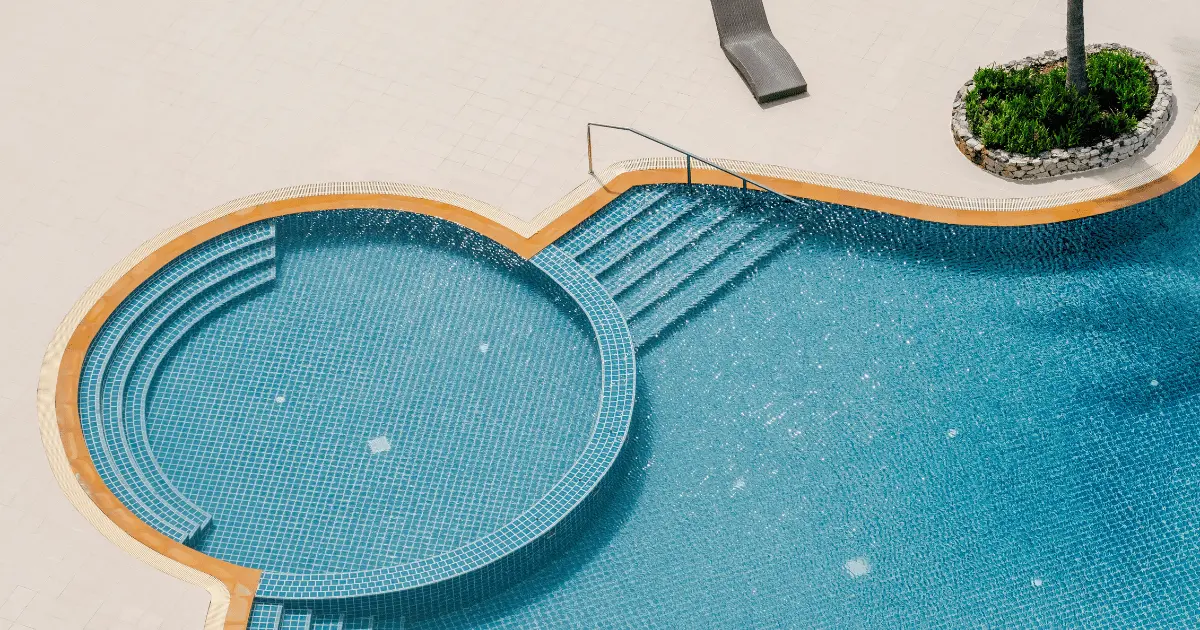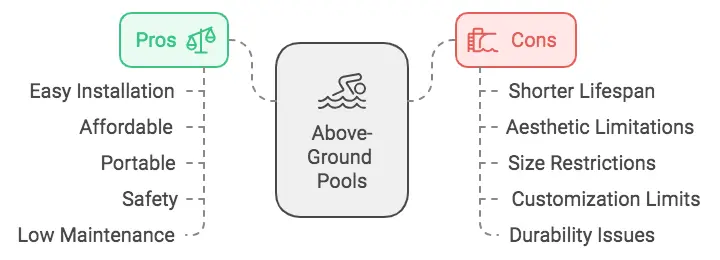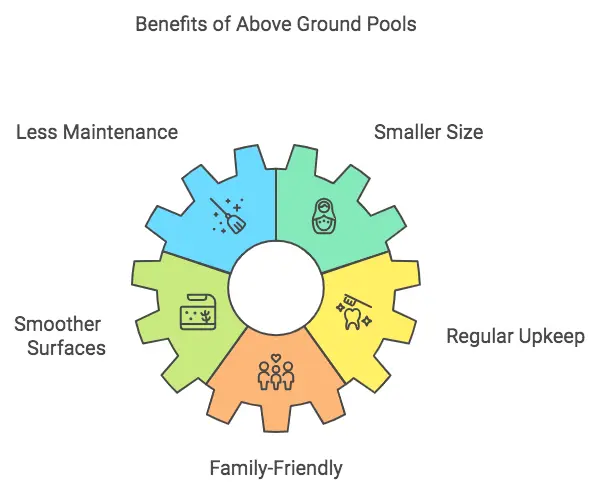CALL US NOW!
+91-213-666-0027
CALL US NOW!
+91-213-666-0027
Above Ground Pools Pros And Cons 2024
- Home
- Above Ground Pools Pros And Cons 2024

Above ground pools are an excellent choice for families who want a fun and affordable pool in their backyard. They’re easy to set up and care for, but they don’t last as long as other pools and don’t offer as many design options. If you’re thinking about getting one, it’s essential to understand the good and the not so good parts to decide if it’s the best fit for you. Above Ground Pools Pros And Cons:

Pros of Above-Ground Pools:
- Easy Installation – Quick setup, perfect for DIY enthusiasts.
- Affordable – Lower cost than in-ground pools, making it budget-friendly.
- Portable – Can be moved or dismantled if needed.
- Safety – Raised walls reduce accidental falls; lockable ladders add security.
- Low Maintenance – Requires fewer chemicals and less upkeep.
Cons of Above-Ground Pools:
- Shorter Lifespan – Typically lasts 7 to 15 years.
- Aesthetic Limitations – May not integrate with landscaping.
- Size Restrictions – Smaller than in-ground pools, limiting swimming space.
- Customization Limits – Fewer design and feature options.
- Durability Issues – Liners are prone to punctures and may need frequent repairs.
Table of Contents
Why Are Above Ground Pools So Popular?
Why are above ground swimming pools gaining such popularity? They cater beautifully to families who enjoy D.I.Y. projects, as they can be installed with less hassle and cost. In this post, we’ll explore the pros and cons of above ground swimming pools to help you decide if this type of pool is the right fit for your family.
Above Ground Pools Pros And Cons
Easy Installation: A DIY Dream
Above ground swimming pools are winning hearts with their straightforward installation. Unlike traditional inground pools, they don’t require extensive digging or landscaping. With a few sets of hands, you can have your pool up and ready in no time!
Most above ground pools come with detailed instructions, making it a great DIY project. You won’t need to hire a contractor, saving both time and money. Plus, the installation process can be a fun family activity, bringing everyone together to create a new backyard oasis.
This ease of setup makes above ground pools perfect for those who love DIY projects. If you’re the type who relishes assembling furniture or building garden projects, you’ll find installing an above ground pool a rewarding challenge.
Affordability: A Budget Friendly Option
One of the biggest draws of above ground swimming pools is their cost effectiveness. While in ground pools can cost tens of thousands of dollars, above ground options provide a more budget friendly solution. This makes them accessible to more homeowners who wish to enjoy the luxury of a pool without breaking the bank.
With prices for above ground pools varying widely, there are options to suit every budget. You can find models with essential features at a low cost or opt for more elaborate pools with additional amenities. The choice is yours based on your needs and financial plans.
Because they are cheaper than inground pools, above ground pools allow you to allocate more of your budget to accessories or poolside decor. This flexibility lets you create an inviting outdoor space for family and friends to enjoy.
Versatility and Portability: Pools That Move with You
Another advantage of above ground pools is their versatility and portability. Unlike permanent in ground pools, these pools can be moved or reconfigured as needed, which is ideal for families who might change homes or want to redesign their backyard layout.
The ability to relocate the pool also means you can take it with you if you move, preserving your investment. Additionally, seasonal dismantling can help extend the life of your pool by protecting it during harsh winter conditions.
Above ground pools come in a variety of shapes and sizes, allowing you to choose one that fits perfectly in your available space. Whether you have a small yard or a spacious property, there’s a configuration that will work for you.
Safety Features: Built In Protection
Safety is a top priority for any family considering a swimming pool. Above ground pools come with built in safety features that provide peace of mind. Their raised design makes it harder for unsupervised children or pets to fall in accidentally.
Many models feature lockable ladders or removable steps, adding an extra layer of security. This makes it easy to control access to the pool area, ensuring that little ones aren’t able to enter without supervision.
By choosing an above ground pool, you can enjoy your backyard oasis while knowing that safety measures are in place to protect your family. This is especially important for parents wanting a worry free environment for their children.
Minimal Maintenance: Low Effort Enjoyment
Above ground pools generally require less maintenance compared to in ground options. This is partly due to their size and the materials used in construction. Smaller pool sizes mean less water to clean and fewer chemicals required.
The surfaces of above ground pools are often smoother, reducing the likelihood of algae buildup. Cleaning these pools is more straightforward and quicker, allowing you to spend more time enjoying the water rather than maintaining it.
With regular upkeep, an above ground pool will provide years of enjoyment without demanding excessive time or effort. For busy families, this low maintenance aspect is a significant benefit.
Lifespan and Durability: How Long Will It Last?
While above ground pools are an affordable option, they do have limitations in terms of lifespan and durability. Most above ground pools are constructed from materials like steel, resin, or aluminum, which may not withstand extreme weather conditions, as well as concrete in ground pools.

The average lifespan of an above ground pool ranges from 7 to 15 years, depending on the quality of materials and level of maintenance. Proper care and regular inspections can help extend this lifespan, but it’s something to consider when weighing the pros and cons.
It’s essential to evaluate whether a shorter lifespan aligns with your long term plans for your home and outdoor space. Some families may see this as a benefit, allowing for upgrades and changes over time.
Aesthetics and Size Limitations: Beauty vs Function
One of the challenges of above ground pools is their appearance and size limitations. While they offer convenience and cost savings, they might provide a different visual appeal than an in ground pool.
Above ground pools can sometimes appear bulky and may not integrate seamlessly into the natural landscape of your yard. However, with creative landscaping and decking options, you can enhance their aesthetics and create an attractive pool area.
Size can also be a limitation, as above ground pools typically offer a different space for swimming and playing than more extensive inground options. For families seeking a pool for exercise or large gatherings, this is an important consideration.
Maintenance Challenges: Be Prepared for Specific Issues
Though above ground pools generally require less maintenance, they do present some specific challenges. For instance, the pool liner can be prone to punctures and tears, especially if not installed correctly or if sharp objects are present in the pool area.
Leaks in an above ground pool need immediate attention to prevent water waste and damage to surrounding structures. Regularly inspecting the liner and being cautious about items around the pool can mitigate this risk.
Additionally, the filtration system needs to be maintained consistently to ensure water quality. Selecting the right pump and filter is crucial for minimizing maintenance issues and maximizing enjoyment.
Limited Customization Options: Fewer Features, More Savings
When it comes to customizing your pool area, above ground pools offer fewer options than their inground counterparts. While you can add decks or fencing to enhance the pool area, the range of modifications is limited by the pool’s structure and design.
For families seeking a highly personalized pool environment with features like infinity edges, waterfalls, or custom lighting, an in-ground pool might be more suitable. However, the cost savings of above ground pools often outweigh these limitations for many homeowners.
Despite these constraints, creative solutions and thoughtful design choices can transform an above ground pool into a beautiful and functional backyard centerpiece.
Buying Guide for Above Ground Swimming Pools
If you’ve decided an above ground pool is right for you, it’s time to consider the buying process. Start by measuring your available space to ensure the pool will fit comfortably in your yard.
Consider the material of the pool, as this will impact durability and appearance. Steel pools are sturdy but prone to rust, while resin options are resistant to corrosion. Aluminum pools offer a balance between strength and resistance to elements.
Selecting the right pump and filter is essential for maintaining clean and clear water. Research options that suit your pool size and usage frequency, ensuring your system is efficient and easy to maintain.
DIY Installation Tips: Set Yourself Up for Success
If you’re embarking on a DIY installation, ground preparation is vital. Ensure the area is level and free of debris, creating a stable base for the pool. Once the ground is ready, follow the manufacturer’s instructions carefully when setting up the pool structure.
Filling and leveling the pool is a crucial step to achieve even water distribution. Take your time to make sure everything is balanced before adding water.
Basic maintenance guidelines include regular cleaning of the filter, checking water chemistry, and inspecting the pool liner. Establishing a routine will keep your pool in top condition and provide years of enjoyment.
Conclusion: Is an Above Ground Pool Right for You?
Above ground swimming pools offer a practical and cost effective solution for families and DIY enthusiasts looking to add a splash of fun to their backyard. While they have their pros and cons, the decision ultimately depends on your specific needs and budget.
By carefully considering the benefits and drawbacks, as well as following our buying guide and installation tips, you can make an informed choice that suits your lifestyle. We hope you found this guide helpful and encouraging.
FAQs About Above Ground Swimming Pools
1. How long does it take to install an above ground pool?
The installation time for an above ground pool can vary depending on factors such as pool size, complexity, and site preparation. On average, a DIY installation might take a couple of days, whereas professional installations can be completed in a day.
2. Can an above ground pool be heated?
Yes, above ground pools can be heated. There are several options available, including solar covers, gas or electric heaters, and heat pumps. The heater choice depends on your budget, climate, and how often you intend to use the pool.
3. Are above ground pools safe for children and pets?
When properly installed and maintained, above ground pools can be safe for children and pets. It’s important to have safety measures like slides, fencing, pool covers, and alarms in place, as well as ensuring constant supervision during pool use.
4. How much does it cost to maintain an above ground pool?
The cost of maintaining an above ground pool includes expenses such as water, chemicals, electricity for pumps, and routine maintenance supplies. These costs can vary based on pool size and usage, but typically range from $200 to $500 annually.
5. Can above ground pools be left up year round?
In mild climates, above ground pools can be left up year round with proper winterization techniques. In areas with harsh winters, it might be necessary to partially disassemble the pool or use an appropriate cover to protect it from weather damage.
